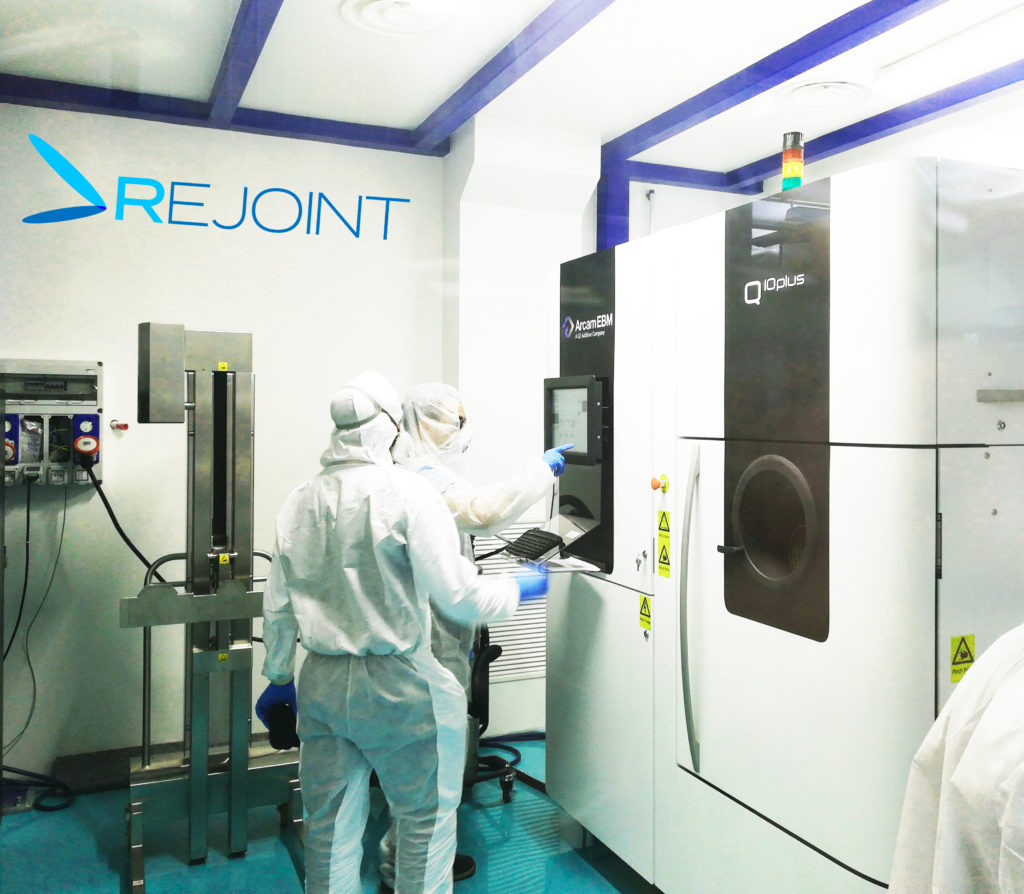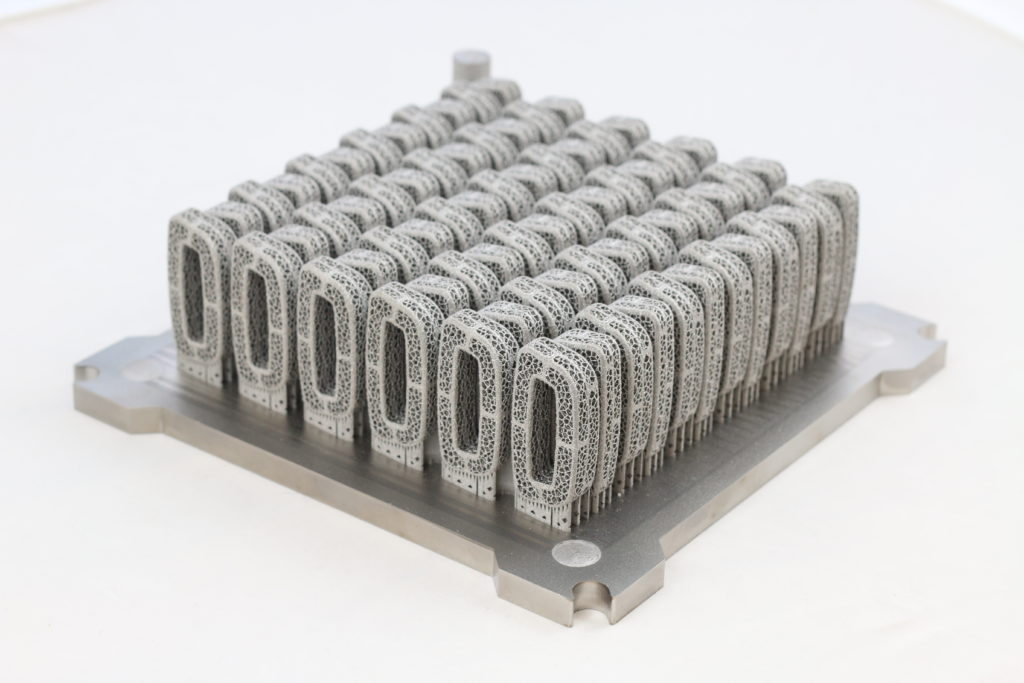REJOINT Uses EBM, Sensors & IoT Data for Patient-Specific Knee Surgery
REJOINT is an Italy based medical device company specializing in Total Knee Arthroplasty operations that received 3 million Euro in EU Horizon 2030 funding in 2019. The firm is seeking US Food & Drug Administration, FDA 510(k) clearance for a new data-driven mass customization approach to patient-specific implants.
In total knee arthroplasty procedures, usually arthritic, knees have their surfaces completely replaced by implants. Total knee arthroplasty is becoming more prevalent as more people enter more advanced ages. More of those people also want to live active lifestyles compared to years ago, when more sedentary lifestyles were the norm. Increasingly people from developing and middle-income countries can also now have these procedures made available to them and younger patients (below 65) are increasingly getting them.
At the same time, these kinds of operations may become more prevalent due to increased obesity. Obesity affects over 1.9 billion adults and over 600 million are clinically obese which in turn can exacerbate osteoarthritis. For “every 5 kg increase in weight, the risk (of the development of knee osteoarthritis) increases by 30%.” Around 45% of TKA patients may have diabetes as well, which is a steadily rising condition in and of itself.
In the US alone some estimate that the prevalence of the procedure will increase by 143% by 2050, while, as of 2015, 7 million adults have had the procedure. In 2010, the prevalence was “1.52%….Prevalence was higher among women than among men and increased with age, reaching…10.38% for total knee replacement at eighty years. These estimates corresponded …. 4.7 million individuals (3.0 million women and 1.7 million men) with total knee replacement in 2010.” Other estimates predict 673% growth in the US until 2030 or even growth of 855%. In the US 790,000 procedures are performed annually, while even a small country as the Netherlands has over 28,000 procedures per year.

REJOINT’s approach puts the firm in the middle of several converging megatrends and the firm is also taking a very trendy approach to improving total knee arthroplasty. By extensively using data, IoT sensors, artificial intelligence, and 3D printing the company hopes to create better mass-customized implants for patients.
REJOINT uses GE’s Arcam EBM technology to make patient-specific implants. On the whole, we would expect that patient-specific implants would hasten procedures and perhaps shorten recovery time because the implants fit the patient better, reducing the length of the procedure and requiring less pushing and shoving by the doctors to make the implant fit.
Pushing and shoving is not used facetiously here. Orthopedic surgeries are a lot less delicate than one may assume. So patient-specific seems like a very logical choice that may be quite beneficial to the patient. Most studies on patient-specific implants have, however, been carried out at the behest of the manufacturers of these implants.
What we do know is that we can get good osseointegration through EBM implants and this is partially why the procedure has grown in popularity in recent years. EBM medical devices can also be comparatively easier to develop through making more iterations possible and are lower cost than conventionally manufactured implants.

Higher specificity of designs and more patient-specific options have been something that the medical device industry has been flirting with for quite a while now, but what should guide patient-specific designs? Can we create specific textures for osseointegration for specific patients or groups of patients? How many sizes of implants are optimal, and do we really need individualized implants? There are no hard and fast answers to these questions at the moment.
What REJOINT has done however is to look further at new data sources that could input implant design and individualization. The company maintains that, “For the patient, over- or under-sizing means constant awareness of the presence of an artificial joint, as well as leading to muscle and ligament decay.” The company also notes, “Patient feedback after an implant can sometimes reflect these issues and indicates that dissatisfaction can be felt by one in five patients and sometimes even to levels of one in four. Dissatisfaction is often largely related to the suboptimal sizing of the implanted prosthesis.”
“To produce the additively manufactured prosthesis, REJOINT starts by 3D modelling the patient’s CT scan. Sophisticated Artificial Intelligence (AI) algorithms are then used to analyze the images and identify the most suitable size for each specific case.
AI is used to compare the unique anatomy of a patient on several thousand prosthetic dimensions, each with as many dimensional variables in specific areas of the implant.
The surgeon is then offered the optimal configuration, for positioning both the prosthetic components and for simulating the operation. This analysis forms the basis for the production of the prosthesis and for patient-specific tools for the planning of the intervention – which is carried out with the support of computer-aided surgery tools.”
In 3D printing for in-the-ear hearing aids, such configuration and placement decisions are still guided by the choice of the operator. By making the configuration step software-guided, the company is making it easier for surgeons to order and receive the right implants for the patient. The risk of choosing the right-sized implant is now also partially offloaded from the surgeon’s shoulders to the device manufacturer. This may reduce some hesitation to go patient-specific by some surgeons and administrators to a certain extent.
The fit system is based in part on Enhatch, a startup that was started by some of Rejoint’s founders. The implants are 3D printed on GE Additive Arcam EBM Q10plus systems in cobalt chrome. In modular hip systems specifically, designers are increasingly opting for cobalt chrome over titanium because, in some cases, the femoral neck portion of some total hip arthroplasty implants has fractured in titanium implants; however, in some very isolated cases, Co-Cr femoral necks have also reportedly failed. Having said that, the jury isn’t out on when which material delivers better results for patients.
Besides just 3D printing, Rejoint data-driven mass customization approach uses web-enabled sensors to provide feedback data to the company which will help it improve its products.
REJOINT CEO, Gian Guido Riva, said of the announcement:
“Having all this data made us realize that we could link it to the information recorded during the operation. And in turn, this data could still be further improved upon if we could collect through the use of wearable devices (such as sensorized headbands and socks), both pre- and post-operative measurements, on how the patient loads their limb or bends their knee, until post-operative evaluation questionnaires have been completed,”
“By 2022, we will have the complete data of thousands of cases available. This will provide us with an unparalleled wealth of application information, in terms of completeness, in the sector. Despite the sale of millions of pieces, there is little or no information on what happens post-sale,”
A real genius element of this is that, “The key element, is an increasingly close and direct relationship between company and patient. This will further increase the degree of post-operative satisfaction. We are at the beginning of a revolution in the field of knee implants. REJOINT’s work in adopting additive technology will allow for more personalized procedures and higher levels of long-term patient satisfaction.”
If REJOINT can strengthen its relationship with the patient and listen intently during the feedback phase, then better implants could result. What will of course most probably be the case is that the soliciting of direct feedback and the closer relationship with the patient that the company is seeking will result in better patient satisfaction. If patients feel more of a connection with the device manufacturer and feel listened to, we would expect them to have a better self-reported feeling towards this procedure and the company. Indeed, the company is now working on a host of mobile apps and web tools to connect it with doctors and patients. Actual listening to patients coupled with a data-driven approach to implant design could very well cause REJOINT to produce better and better-rated implants.
The post REJOINT Uses EBM, Sensors & IoT Data for Patient-Specific Knee Surgery appeared first on 3DPrint.com | The Voice of 3D Printing / Additive Manufacturing.
REJOINT is developing knee replacements with additive manufacturing and artificial intelligence
Inside GE Additive’s Arcam EBM Centre of Excellence, Gothenburg with CEO Jason Oliver
Amplify Additive Adopts Arcam’s EBM for Orthopedic Production
Electron beam melting (EBM) has a unique place in the additive manufacturing (AM) industry in that there is only one EBM hardware manufacturer (GE Additive subsidiary Arcam) and the technology is targeted primarily toward two industry segments: aerospace and orthopedics.
By targeting the orthopedics space, Arcam has won over a number of companies that use its technology specifically for 3D printing orthopedic implants. One of the latest to showcase its use of EBM for 3D printing implants in Maine-based Amplify Additive, which is applying over 20 years-worth of AM experience toward the orthopedics industry.
The company was founded in 2018 as a means of delivering additive solutions to the medical customers, advising them on design, supply chain strategies and how to improve time to market. Amplify opened its first production facility in 2019, which now runs three Q10plus machines and will be obtaining an ISO 13485:2016 certification.
According to founder Brian McLaughlin, Amplify Additive often acts as a go-between for doctors and designers because the organizations they work with don’t have the infrastructure necessary to run additive systems and produce end-use parts.
“We often to act as the bridge between two very different disciplines – orthopedic surgeons and design engineers,” McLaughlin said. “Teams often have a shared vision, but uncertainty about how best to implement additive can sometimes present hurdles to overcome. We’re able to use that combination to add value and offer organizations solutions to overcome those hurdles – because we implicitly understand both sides of the conversation.”
According to SmarTech Analysis, the orthopedic segment of the additive manufacturing market generated nearly $200 million in 2016 and is expected to grow by about 30 percent CAGR until at least 2025. While AM will lead to an increasing amount of patient-specific medical treatments more broadly, EBM in particular has specific benefits for 3D-printed orthotics.
The technology results in a rougher final texture directly from the print bed than metal parts printed with laser powder bed fusion, which in turn generates greater bone growth and adhesion (“osseointegration”). Additionally, Arcam machines feature a scanning system that quickly switches the electron beam between surface locations and maintains a melt pool at the same time, allows for rapid fabrication. This, especially when combined with the stacking of parts within the build chamber, benefits serial production.
Amplify is aiming to position itself as an orthopedic center of excellence for AM in the U.S. and, later, around the globe. It doesn’t plan to limit itself to just one of Arcam’s two major verticals, however. After it establishes success in the orthopedic sector Amplify will target the aerospace market as well.
The post Amplify Additive Adopts Arcam’s EBM for Orthopedic Production appeared first on 3DPrint.com | The Voice of 3D Printing / Additive Manufacturing.
The 3D Printing Industry news bulletin
Titomic announces powder supply agreement and MoU with GE Additive company AP&C
GE Additive champions lean manufacturing in new Arcam EBM Center of Excellence
2019 3D Printing Industry Awards update Enterprise 3D Printer of the Year Metal and Polymers
Interview with Fabio Sant´Ana of Farcco Tecnologia About Metal Printing and 3D Printing in Brazil

Farcco Tecnologia is a company devoted to introducing Additive Manufacturing technologies to the Brazilian Industries, it is specialized in real metal additive production technology, and is really reaching out to every possible specialization in AM . The main focus is expanding the knowledge of Brazilian market. Farcco researches and finds the most important technologies thru shows, conferences , training and suppliers to make Brazilian Industries to reach the same level of capability and expertise found overseas .
The Brazilian Additive Manufacturing market is developing in slower pace, the last 8 years did hold Brazil back in terms of R&D. In a not growing, or more in a depressed economy, is hard for companies to justify investment in new, and technology advanced, manufacturing capacities. Starting in 2018 with the new government , companies started to forecast economic growth for the next years and this made the industrial environment reach out to us, for 3D printing, to revamp their production resources. In Brazil the medical market is the first adopter in additive and had the first equipment, this is being used for manufacturing titanium implants. During 2017 and 2018, more companies are beginning to understand the real advances of the technology and its benefits in quality, product development and cost saving features. Aerospace started to evaluate AM during 2018 and the first metal machine should be working in Q1 2019 . Most machines installed before this new boom time are in Universities and Research Institutes.
Brazil has a very limited investment capability, this is what holds us back, the startup environment is not well supported by banks and startups normally only rely on Private Equity and Angel Investments. AM is very capital intensive in case of equipment for startups and this makes it difficult to do.
Call me ! … Joking … anyway , Brazil is different in many ways. Lack of infrastructure and investment as well as a difficult tax structure create many entrance barriers for foreign companies , To find a very knowledgeable local partner is something that can keep the company on right track with the right information one can jump many steps and problems. To invest in training of locals to support the “pre” and “after” sales is also a good advice . Brazilian Industry is used to local support and short service time.
The EBM process has some nice specific characteristics that benefit reactive materials such as titanium, it can supply more energy and generates up to 70 simultaneous melt pools. This is what lets you grow fast compared with other process that have 1 , 2 or 4 melt pools. The way electron beam hits the powder is different than laser, that is basic light and has its particular ways of propagation reflection etc. In EBM energy loss is much lower that also benefits the process. EBM is a less precise in terms of geometry, but can stack parts filling the build chamber, another benefit in terms of production quantities and gives one more balanced building cycles. Each process has its advantages. Laser has a very good precision and also better finished surface, this can work well with steel and forms a less compact build cake what makes cleaning the powder easier in cases of something such as conformal cooling . In Additive Manufacturing each process has its right business case. Every technology has its niches and must be well understood to give you the best results.
The Q10+ and Q20+ have reached a very stable processing and performance. The Spectra is a big chamber focused on TiAl and bigger quantites. The products are all reaching a very mature state.
Let me tell you how I started in Additive, I’ve been a machining guy since 1991 when I left the Precision Mechanics Technical High School. I’ve been supplying the market with CNC machining equipment since 1992 had to develop skills in 3D manufacturing since that time , from complex mass production processes to really difficult 5 axis applications all in my range. In 2013 a medical implants company R&D manager and friend came to me with a very crazy part he found in Europe and asked me how to make that thing. I told him ” I dont know , yet “. My Additive journey started in that day of 2013, after almost 6 years researching, learning, teaching and going all over the world to be able to implement additive equipment and technologies, I know that each technology has its case, binder jetting cases will appear, no doubt. But, for now, I don’t know yet.


